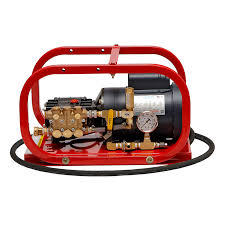What You Need to Know about Hydrostatic Test Pump
2024-04-17
Hydrostatic test pumps are specialized pumps used to conduct hydrostatic pressure testing on a variety of pressure vessels, pipelines, plumbing systems, and other components. Here's what you need to know about hydrostatic test pumps:
1. Principle of Operation:
- Hydrostatic test pumps work by pressurizing a fluid (usually water or oil) to a specific pressure level and then applying that pressure to the system being tested.
- These pumps typically consist of a pump unit, pressure gauge or manometer, hoses or fittings for connection, and sometimes a reservoir or tank for holding the testing fluid.
- The pump generates pressure by displacing the testing fluid, which is then transferred to the system being tested via hoses or fittings.
- A pressure gauge or manometer attached to the pump indicates the pressure level, allowing the operator to monitor and control the test pressure.
2. Key Features:
- Pressure Range: Hydrostatic test pumps are available in a range of pressure capacities to suit different testing requirements, from low-pressure applications to high-pressure testing.
- Portability: Some hydrostatic test pumps are designed for portable use, featuring compact and lightweight designs for easy transport to testing locations.
- Durability: Quality hydrostatic test pumps are constructed from durable materials such as stainless steel or aluminum to withstand the rigors of testing environments.
- Accuracy: These pumps offer precise pressure control and accurate pressure readings, ensuring reliable testing results.
- Safety Features: Many hydrostatic test pumps include safety features such as pressure relief valves, burst discs, or overload protection mechanisms to prevent overpressurization and ensure operator safety.
3. Applications:
- Hydrostatic test pumps are commonly used in various industries and applications, including:
- Pressure vessel and tank testing
- Pipeline and hydraulic system testing
- Plumbing and HVAC system testing
- Fire sprinkler system testing
- Laboratory and research applications
- Quality control and inspection processes
4. Usage Considerations:
- Before using a hydrostatic test pump, ensure that it is suitable for the intended application and pressure range.
- Follow manufacturer instructions and safety guidelines when operating the pump to prevent injury or damage to equipment.
- Conduct pressure tests in a controlled environment and use appropriate safety precautions to minimize risks.
- Regular maintenance and calibration may be necessary to ensure the pump's accuracy and performance over time.
Hydrostatic test pumps are essential tools for conducting pressure tests to verify the integrity and performance of pressure vessels, pipelines, and other critical components, providing crucial data for safety compliance, quality assurance, and system reliability.



